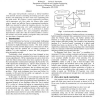13 search results - page 2 / 3 » Clock buffer and wire sizing using sequential programming |
ICCAD
2001
IEEE
14 years 1 months ago
2001
IEEE
This paper hierarchically constructs a hybrid mesh/tree clock network structure consisting of overlying zero-skew clock meshes, with underlying zero-skew clock trees originating f...
CNSR
2010
IEEE
13 years 8 months ago
2010
IEEE
— Buffered crossbar (CICQ) switches have shown a high potential in scaling Internet routers capacity. However, they require expensive on-chip buffers whose cost grows quadratical...
ISPD
2000
ACM
13 years 9 months ago
2000
ACM
In this paper, we present an algorithm for delay minimization of interconnect trees by simultaneous buffer insertion/sizing and wire sizing. The algorithm integrates the quadratic...
ISPD
2004
ACM
13 years 10 months ago
2004
ACM
As the CMOS technology is scaled into the dimension of nanometer, the clock frequencies and die sizes of ICs are shown to be increasing steadily [5]. Today, global wires that requ...
TCAD
1998
13 years 4 months ago
1998
— Conventional methods for optimal sizing of wires and transistors use linear resistor-capacitor (RC) circuit models and the Elmore delay as a measure of signal delay. If the RC ...

